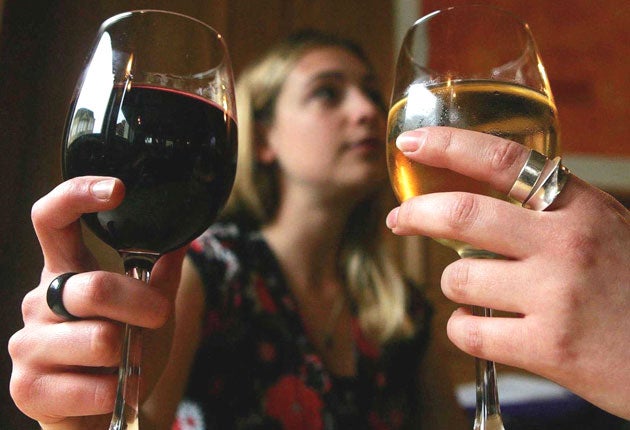One in three adults drinks more than they should
Alcohol abuse worst among middle-classes, survey by ONS reveals

Your support helps us to tell the story
From reproductive rights to climate change to Big Tech, The Independent is on the ground when the story is developing. Whether it's investigating the financials of Elon Musk's pro-Trump PAC or producing our latest documentary, 'The A Word', which shines a light on the American women fighting for reproductive rights, we know how important it is to parse out the facts from the messaging.
At such a critical moment in US history, we need reporters on the ground. Your donation allows us to keep sending journalists to speak to both sides of the story.
The Independent is trusted by Americans across the entire political spectrum. And unlike many other quality news outlets, we choose not to lock Americans out of our reporting and analysis with paywalls. We believe quality journalism should be available to everyone, paid for by those who can afford it.
Your support makes all the difference.Doctors are demanding mandatory labelling for alcoholic drinks to help consumers keep track of their consumption as figures showed that one in three adults regularly drinks over the safe limits.
Figures from the Office for National Statistics (ONS) for 2007 show binge drinking is widespread and is most prevalent among the better-off, wine-imbibing middle classes. Smoking fell to its lowest recorded level of 21 per cent but with the reverse social gradient: it is highest among manual workers and lowest among professional groups.
More than a third of adults (37 per cent) exceeded the daily safe limits for drinking – three to four units for men and two to three for women – on at least one day a week. The proportion rose to 43 per cent among professional and managerial groups, compared with 31 per cent amongst manual workers.
A unit of alcohol is half a pint of ordinary beer, a small glass of wine or a single measure of spirits. The "safe" limits represent doctors' judgement on the daily amount of alcohol that is unlikely to do harm. They replaced the earlier weekly limits of 28 units for men and 21 units for women because many drinkers were saving up their units for a weekend bender while still claiming to be drinking safely.
The ONS figures show that one in five adults consumed more than double the safe limits on their heaviest drinking day of the week – a small rise on the previous year. More of them are men (24 per cent) than women (15 per cent).
The Royal College of Physicians demanded yesterday that the Government acts to stem the damage caused by alcohol. Its president, Professor Ian Gilmore, said: "On the basis of these figures it appears unlikely that we will stem the tide of alcohol-related health harms in the near future. While people's awareness of the health risks... is surprisingly good, knowledge of the recommended limits is still poor, despite 10 years of work to raise awareness.
"It is vital that the Government introduce mandatory labelling on drinks so that people are in a better position to keep track of their consumption levels."
Among women, 77 per cent did their heaviest drinking at home or in someone else's home, compared with 54 per cent of men. Professor Gilmore said that "as more people socialise at home rather than in pubs and bars" labelling was especially important.
The figures coincided with publication of the first report from the National Treatment Agency on under-18s with drug and alcohol problems, which showed a 33 per cent rise to almost 24,000 in the number receiving treatment between 2005-06 and 2007-08. Four out of five were treated for problems with cannabis or alcohol. The NTA said the rise reflected the increase in investment in treatment programmes, from £15m to £25m over the past five years. "The numbers have grown because... treatment is more widely available," said Rosanna O'Connor, the director of delivery at the NTA; drug use overall by young people was declining.
The Department of Health said it had asked the the drinks industry to introduce voluntary labelling of alcohol content. Monitoring of compliance "will take place early in 2009", a spokesman said.
3 - 4
The number of daily units of alcohol deemed safe for men.
Join our commenting forum
Join thought-provoking conversations, follow other Independent readers and see their replies
Comments